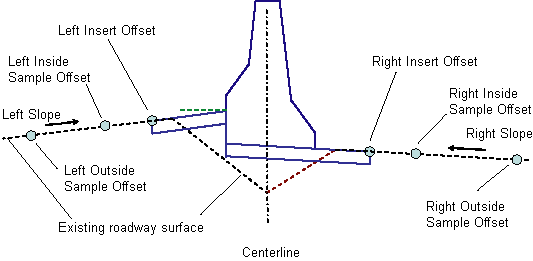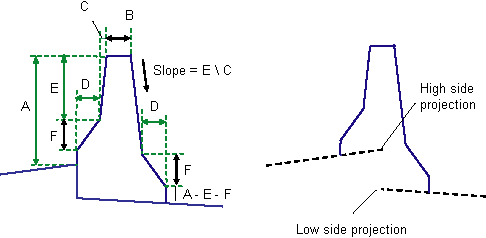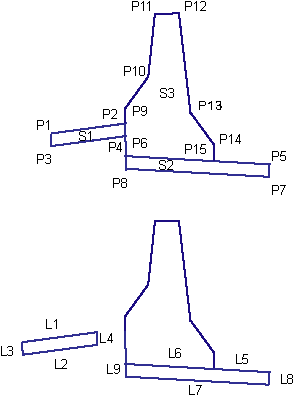This subassembly widens an existing divided highway by extending from the travel lane edges inward over a depressed median, with an asymmetrical barrier at the centerline to resolve elevation differences. It includes an option to tie the top-of-barrier elevation to a predefined profile.


Attachment
The attachment point is the center of the base of the barrier.
Input Parameters
Note: All dimensions are in meters or feet unless otherwise noted. All slopes are in run-over-rise form (for example, 4 : 1) unless indicated as a percent slope with a “%” sign.
|
Parameter |
Description |
Type |
Default |
|---|---|---|---|
|
Overlay Depth |
Thickness of the median overlay layers. |
Numeric, positive |
0.100 m 0.3 ft |
|
Left Insert Offset |
Offset where the median extension layer begins on the left side. |
Numeric |
0.0 |
|
Left Inside Sample Offset |
Offset of the inside sample point on the left side. The slope of the left side is calculated on the existing surface between the sample points. |
Numeric |
0.0 |
|
Left Outside Sample Offset |
Offset of the outside sample point on the left side. The slope of the left side is calculated on the existing surface between the sample points. |
Numeric |
0.0 |
|
Right Insert Offset |
Offset where the median extension layer begins on the right side. |
Numeric |
0.0 |
|
Right Inside Sample Offset |
Offset of the inside sample point on the right side. The slope of the right side is calculated on the existing surface between the sample points. |
Numeric |
0.0 |
|
Right Outside Sample Offset |
Offset of the outside sample point on the right side. The slope of the right side is calculated on the existing surface between the sample points. |
Numeric |
0.0 |
|
Dimension A (mm or inches) |
Height of the barrier from the base on the high side of the median to the top of the barrier. |
Numeric, positive |
810 mm 32 in |
|
Dimension B (mm or inches) |
As shown in diagram. |
Numeric, positive |
232 9 in |
|
Dimension C (mm or inches) |
As shown in diagram. |
Numeric, positive |
59 mm 2 in |
|
Dimension D (mm or inches) |
As shown in diagram. |
Numeric, positive |
125 mm 5 in |
|
Dimension E (mm or inches) |
As shown in diagram. |
Numeric, positive |
557 mm 22 in |
|
Dimension F (mm or inches) |
As shown in diagram. |
Numeric, positive |
178 mm 7 in |
Target Parameters
This section lists the parameters in this subassembly that can be mapped to one or more target objects, such as a surface, alignment, or profile object in a drawing. For more information, see To Specify Corridor Targets.
|
Parameter |
Description |
Status |
|---|---|---|
|
Existing Surface |
Name of the Surface defining the existing roadway. The following object types can be used as targets for specifying this surface: surfaces. |
Required |
|
Top of Barrier |
May be used to tie the top of barrier to the elevation of a profile. Dimension E may vary to achieve the calculated barrier height. The following object types can be used as targets for specifying this elevation: profiles, 3D polylines, feature lines, or survey figures. |
Optional |
|
Left Insert Offset |
May be used to calculate the offset of the left insert point from an alignment. The following object types can be used as targets for specifying this offset: alignments, polylines, feature lines, or survey figures. |
Optional |
|
Left Inside Sample Offset |
May be used to calculate the offset of the left inside sample point from an alignment. The following object types can be used as targets for specifying this offset: alignments, polylines, feature lines, or survey figures. |
Optional |
|
Left Outside Sample Offset |
May be used to calculate the offset of the left outside sample point from an alignment. The following object types can be used as targets for specifying this offset: alignments, polylines, feature lines, or survey figures. |
Optional |
|
Right Insert Offset |
May be used to calculate the offset of the right insert point from an alignment. The following object types can be used as targets for specifying this offset: alignments, polylines, feature lines, or survey figures. |
Optional |
|
Right Inside Sample Offset |
May be used to calculate the offset of the right inside sample point from an alignment. The following object types can be used as targets for specifying this offset: alignments, polylines, feature lines, or survey figures. |
Optional |
|
Right Outside Sample Offset |
May be used to calculate the offset of the right outside sample point from an alignment. The following object types can be used as targets for specifying this offset: alignments, polylines, feature lines, or survey figures. |
Optional |
Output Parameters
None.
Behavior
The left and right slopes are calculated between the sample points on each side. Lines from the cutout points are extended inward at these slopes to the centerline. The side with the highest elevation at the centerline determines the controlling side for the minimum height of the barrier.
The offset of the barrier base on the high side is calculated from the given dimensions. The overlay layer on the high side is extended from the cutout point to this offset.
The overlay layer on the low side is extended from the cutout point to the offset of the barrier base on the high side.
The barrier is constructed from the base point on the high side, closing to the top of the overlay layer on the low side, as shown in the diagram.
If a top-of-barrier profile is given as a target parameter, the height of the barrier is controlled by the profile. Dimension E may vary to achieve this height.
Layout Mode Operation
In layout mode, a symmetrical median and barrier are drawn with the fixed dimensions shown below. This is the same figure that is drawn in layout mode for the OverlayMedianSymmetrical subassembly.

Point, Link, and Shape Codes
The following table lists the point, link, and shape codes for this subassembly that have codes assigned to them. Point, link, or shape codes for this subassembly that do not have codes assigned are not included in this table.
|
Point, Link, or Shape |
Code |
Description |
|---|---|---|
|
P1, P5 |
ETW |
Beginning of median extension at top of overlay |
|
P3, P7 |
ETW_Overlay |
Beginning of median extension at bottom of overlay |
|
All barrier points |
Barrier |
|
|
L1, L5 |
Top |
Exposed top of overlay layers |
|
L2 - L4 |
Overlay |
|
|
L7 - L9 |
Overlay |
|
|
All barrier links |
Barrier |
|
|
S1, S2 |
Overlay |
|
|
S3 |
Barrier |
Coding Diagram
The mirror image will apply when the high side of the median is on the right instead of the left.
